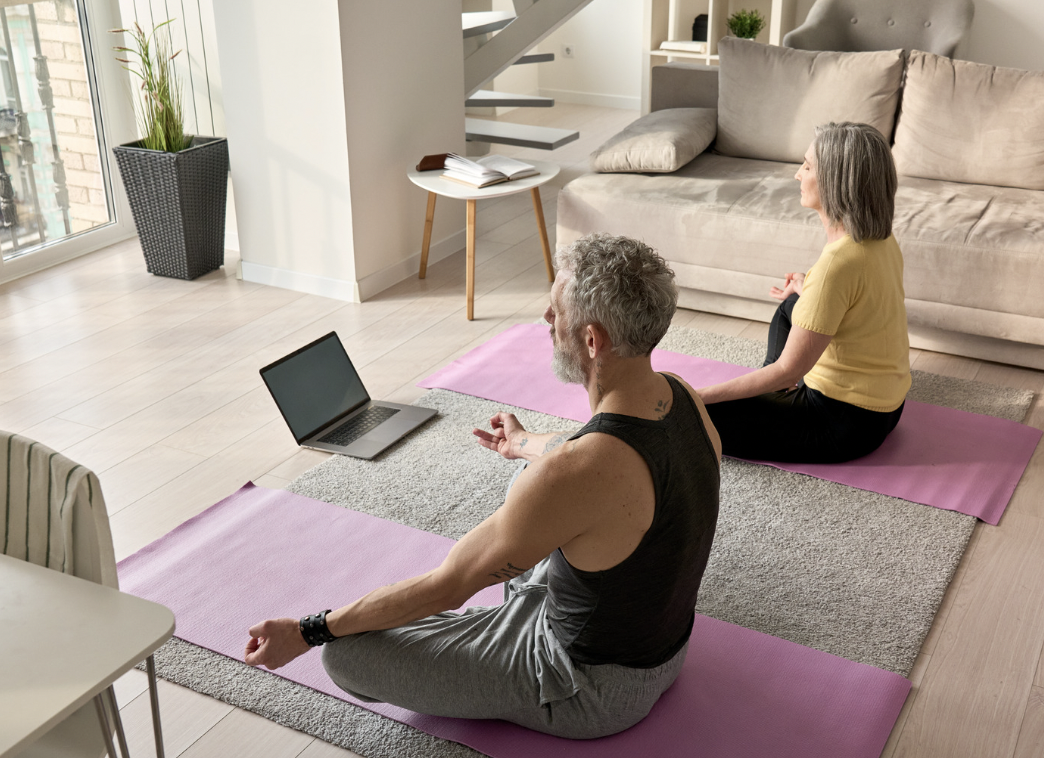A few weeks ago, we talked about simple standing yoga poses for seniors.
Today, to continue the flexible goodness, we’ll explore yoga from a different position: the floor!
Physical limitations like injury, disability and balance problems can make standing difficult. And sometimes, it’s just easier to build yoga practice from the ground up. Literally.
No equipment is necessary for the poses discussed below. But, to take the comfort level up a notch, use a yoga mat like this one.
1. Staff Pose (Dandasana)
Staff pose helps build core components needed for other yoga poses. It creates awareness of the back and shoulders, and builds good posture and a strong core. It allows us to connect with our foundation for increased stability.
To do Staff Pose:
- Sit on the floor, legs out forward and gently together.
- Keeping palms on the floor, bring hands next to the hips and straighten the arms.
- If possible, touch the big toes together, leaving a bit of space between the heels.
- Flex the ankles a few times. Then, point the toes gently towards the face.
- Sit up tall, being mindful not to slouch. The shoulders should be relaxed, and the chest facing forward (not down).
- Tuck the chin very slightly, so the top of the head points towards the ceiling.
- Hold the pose for 30 seconds, or as long as is comfortable.
Staff pose: https://www.youtube.com/watch?v=sXz0OCjO3p4
2. Bound Angle Pose (Baddha Konasana)
Seemingly a favorite of gym teachers everywhere, bound angle pose (sometimes called cobbler’s pose or butterfly pose) is great for stretching the hips, knees, and groin.
It also helps lengthen and stretch the back muscles, and build better posture.
The pose requires us to sit with our knees bent, feet pressed together, while we hold our ankles with both hands.
To do Bound Angle Pose:
- Start in staff pose.
- Bring one knee in, and then the other, so the soles of the feet are touching. Depending on flexibility, the knees may or may not touch the ground. Both are okay.
- Gently grab hold of the left ankle with the left hand, right ankle with the right hand.
- Sit up tall, spine straight.
- To stimulate the hips and legs, move the legs up and down slowly, like they are butterfly wings flapping.
- Stop moving the legs, and find a moment of stillness in the pose.
- Hold for 30 seconds.
Bound Angle Pose: https://www.youtube.com/watch?v=-oWWAuKc5Ww
3. Easy Pose (Sukhasana)
We’re probably all familiar with the kindergarten “criss-cross-apple-sauce” position. This is very similar to the most basic variation of easy pose.
It helps stretch our back muscles, spine, hips, and ankles. Easy pose also encourages mental relaxation.
And while the position is simple, it might not be easy for everyone. So, don’t fret if it’s difficult at first.
To do Easy Pose:
- From bound angle pose, move the legs under the body so they’re in a criss-cross position.
- If needed, put a folded blanket or towel underneath the bum. This helps lift the hips, making the pose comfier.
- Sit up tall.
- Engage the core. Imagine trying to touch the belly button to the spine.
- Put the hands on the knees, facing up or down depending on what feels best.
- Breathe in deeply. Exhale deeply. Do this for ten breath cycles.
Easy pose: https://www.youtube.com/watch?v=zLvJD7iKVhw
Summary
Yoga is great for building strength, flexibility, and mindfulness. It doesn’t have to be complicated to be beneficial. Simple, foundational floor poses can help us feel stronger and more connected to ourselves.
Sources

